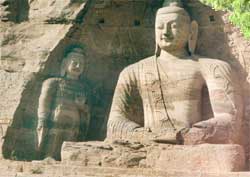Yungang Caves
 Why the
Yungang Caves
are special
Why the
Yungang Caves
are specialYungang Caves are China's greatest single venue of Buddhist statues. They were carved 1500 years ago.
Yungang Caves tips and insights
Number
A few interesting statistics illustrating Yungang's massive construction and artistic endeavors:
- Caves and statues
Yungang Caves have 53 caves and 51,000 statues depicting Buddha and his life.
- Size
Statue heights ranges in extremes from thumb size to 17 meters (55 feet).
- Workforce
The cave complex and statuary were created by 40,000 workers.
Be sure to reserve ample time for these:
- Cave 5
Extensively carved. This is the artistic glory of the Yungang caves.
- Cave 11
Notable for its thousands of Buddhist carvings on the walls and ceilings.
- Cave 18
The home of a tall Buddha statue.
- Cave 6
Boasts a seated Buddha of giant proportions.
- Cave 20
Houses the giant seated Buddha shown in the above photo. It is bathed in sun light because its wall collapsed, exposing the statue to the outdoors.
Yungang: yoo'ng-gahng
Monks
Once, thousands of Buddhist monks lived within the Yungang Caves complex.
About the carving
- Peak period
Most of the significant caves were carved out in the 5th century. Then, the serious carving was suddenly ceased as the realm moved its imperial seat to a distant city.
- Sandstone rock
The grottoes and statues were physically easy to carve out because sandstone rock is a relatively soft stone, a sculptor's dream.
- Few of the statues
are free standing
Most statues were carved directly into the cave walls (the hollows created niches for the statues).
The Yungang Caves lie 16 kilometers (10 miles) west of Datong in Shanxi province.


